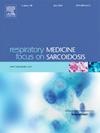神经肌肉电刺激对间质性肺疾病患者运动能力、肌肉力量、体力活动和生活质量的影响:一项随机研究
IF 3.1
3区 医学
Q2 CARDIAC & CARDIOVASCULAR SYSTEMS
引用次数: 0
摘要
神经肌肉电刺激(NMES)已被研究用于各种心肺疾病;然而,其对间质性肺疾病(ILD)的影响仍知之甚少。目的探讨NMES对ILD患者运动能力、肌力、生活质量和体力活动的影响。方法前瞻性、随机、对照、三盲研究。NMES组19例患者接受双侧股四头肌(QF) 40 Hz的NMES,持续20分钟,每周3次,持续6周,同时每天进行呼吸练习。对照组的18名患者单独进行了6周的呼吸练习。测量前后的结果包括:6分钟步行测试(6MWT),增量穿梭步行测试(ISWT),最大吸气和呼气压力(MIP, MEP), QF肌肉力量,生活质量(SGRQ, LCQ),身体活动,呼吸困难(MMRC量表)和疲劳(FSS)。结果与对照组相比,NMES组在6MWT距离、MMRC、能量消耗、体力活动持续时间和每日步数方面均有显著改善,FSS评分也有所提高(p = 0.025)。ISWT、MIP/MEP、SGRQ或LCQ评分组间无显著差异(p > 0.05)。虽然6MWT距离增加(p = 0.002),但NMES组QF肌力保持不变,而对照组QF肌力下降(p = 0.018)。结论nmes是一种可行有效的干预措施,可提高ILD患者的运动能力和体力活动水平,同时保持肌肉力量,减轻呼吸困难。这意味着将NMES纳入ILD患者的康复计划可能会提高他们的整体身体表现和生活质量。本文章由计算机程序翻译,如有差异,请以英文原文为准。
Effects of neuromuscular electrical stimulation on exercise capacity, muscle strength, physical activity, and quality of life in patients with interstitial lung diseases: A randomized study
Background
Neuromuscular electrical stimulation (NMES) has been investigated for various cardiopulmonary conditions; however, its effects on interstitial lung disease (ILD) remain poorly understood.
Objective
To investigate the effects of NMES on exercise capacity, muscle strength, quality of life, and physical activity in ILD patients.
Methods
This was a prospective, randomized, controlled, triple-blinded study. Nineteen patients in the NMES group received NMES on the bilateral quadriceps femoris (QF) at 40 Hz for 20 min, three times a week for six weeks, along with daily respiratory exercises. Eighteen patients in the control group performed respiratory exercises alone for six weeks. Outcomes measured before and after included: 6-min walk test (6MWT), incremental shuttle walk test (ISWT), maximum inspiratory and expiratory pressures (MIP, MEP), QF muscle strength, quality of life (SGRQ, LCQ), physical activity, dyspnea (MMRC scale), and fatigue (FSS).
Results
The NMES group demonstrated significant improvements in 6MWT distance, MMRC, energy expenditure, physical activity duration, and daily step count, with increased FSS scores compared to the control group (p = 0.025). No significant differences were observed between groups for ISWT, MIP/MEP, SGRQ, or LCQ scores (p > 0.05). While 6MWT distance improved (p = 0.002), QF muscle strength was preserved within the NMES group but decreased within the control group (p = 0.018).
Conclusion
NMES is a feasible and effective intervention for enhancing exercise capacity and physical activity levels, while preserving muscle strength and reducing dyspnea in patients with ILD. This implies that incorporating NMES into the rehabilitation programs of ILD patients may enhance their overall physical performance and quality of life.
求助全文
通过发布文献求助,成功后即可免费获取论文全文。
去求助
来源期刊

Respiratory medicine
医学-呼吸系统
CiteScore
7.50
自引率
0.00%
发文量
199
审稿时长
38 days
期刊介绍:
Respiratory Medicine is an internationally-renowned journal devoted to the rapid publication of clinically-relevant respiratory medicine research. It combines cutting-edge original research with state-of-the-art reviews dealing with all aspects of respiratory diseases and therapeutic interventions. Topics include adult and paediatric medicine, epidemiology, immunology and cell biology, physiology, occupational disorders, and the role of allergens and pollutants.
Respiratory Medicine is increasingly the journal of choice for publication of phased trial work, commenting on effectiveness, dosage and methods of action.
 求助内容:
求助内容: 应助结果提醒方式:
应助结果提醒方式:


